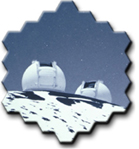 |
Natural Guide Star Adaptive Optics
The Keck NGS AO system produces Strehl ratios as high as 65% at K-band and 45% at H-band. The AO system works well with extended sources as large as Uranus (4 arcsec). Near diffraction-limited can be obtained using guide stars as faint as Rmag=15.5, with partial correction on stars up to a magnitude fainter. However, since the AO system can also use the laser guide star, we recommend that you attempt to observe targets with guide stars fainter than Rmag=15 using LGS AO if possible for improved performance.
NGS AO starlists are now required to be formatted in a format similar to the LGS AO starlists.
Please read the webpage on AO starlists for more information.
Papers on Keck NGS AO:
In October 2006 (Keck I) and February 2007 (Keck II), the AO systems were upgraded with a new wavefront sensor and a new wavefront controller. A Keck Adaptive Optics Note on the performance of the AO system can be found below:
KAON 489: Performance of the Keck II AO System (2007).
The references below refer to the old wavefront controller, but the information on this webpage has been updated with new values.
|
- Keck NGS AO performance:
M.A. van Dam et al. 2004,
Appl. Opt., 43, 5458-5467.
- Adaptive Optics Developments at Keck.
Wizinowich, P., et al. 2004, Proc. SPIE Glasgow.
- Keck NGS AO first light paper:
Wizinowich, P., et al. 2000,
PASP 112, 315-319.
- "Characterization of adaptive optics at Keck Observatory: part II", SPIE, Glasgow, 2004
- "Characterization of adaptive optics at Keck Observatory", SPIE, San Diego, 2003
- SPIE August 2003, San Diego Presentation
|
|
|
Typical performance:
| Median to good seeing, on-axis |
| R mag. |
K-band Strehl |
H-band Strehl |
| 7.0 |
0.58 |
0.40 |
| 11.0 |
0.54 |
0.37 |
| 13.0 |
0.50 |
0.33 |
| 13.5 |
0.47 |
0.31 |
| 14.0 |
0.40 |
0.20 |
| 14.5 |
0.32 |
0.15 |
| 15.0 |
0.22 |
- |
| 15.5 |
0.12 |
- |
| 16.0 |
0.05 |
- |
|
| Bright guide star K-band Strehl |
K-band Strehl vs magnitude |

|

|
These plots show measured K-band Strehl ratios as a function of r0 and guide star magnitude.
Point-spread functions at K-band:
Comparison of J, H and K point-spread functions
These PSFs were measured with AO locked on a 7.5-mag star.
Isoplanatism

Strehl vs. angular offset
|
Measurements were made of isoplanatism on M11, the Wild Duck Cluster. The AO system was locked on a V=11.2 star and images were taken of the guide star. Then the telescope was offset to four off-axis stars and images were taken at each star. The Strehl ratio as a function of angular offset is plotted below.
|
Sky coverage

Sky coverage vs. Galactic latitude
|
The fractional sky coverage at K' Strehls of 0.1, 0.2, and 0.3 is shown
in the plot to the left, calculated using the galactic model of
Bachall and Soneira (1980)
and transformed to R by Simons (1995), the on-axis K' Strehl versus R magnitude tabulated above, a K' isoplanatic angle of 20'' and the Maréchal approximation. The isoplanatic angle used is higher than is obtained by analytic expressions from measured profiles (11-16'') to allow for the fact that both the Maréchal approximation and the analytic expressions for anisoplanatism underestimate the Strehl ratio. The maximum viewable distance from the guide star is limited by the field steering mirrors to 25''.
|
|
Links to other websites:
- Strehl meter: Information on an IDL tool to measure Strehl ratios and downloads of the tool for NIRC2 and any other telescope or optical system.
- LGS AO Page: Information on the laser guide star adaptive optics system at Keck Observatory.
This page was last updated on 07/13/2016 22:11:07
For more information, please contact
Marcos van Dam.
|
|














